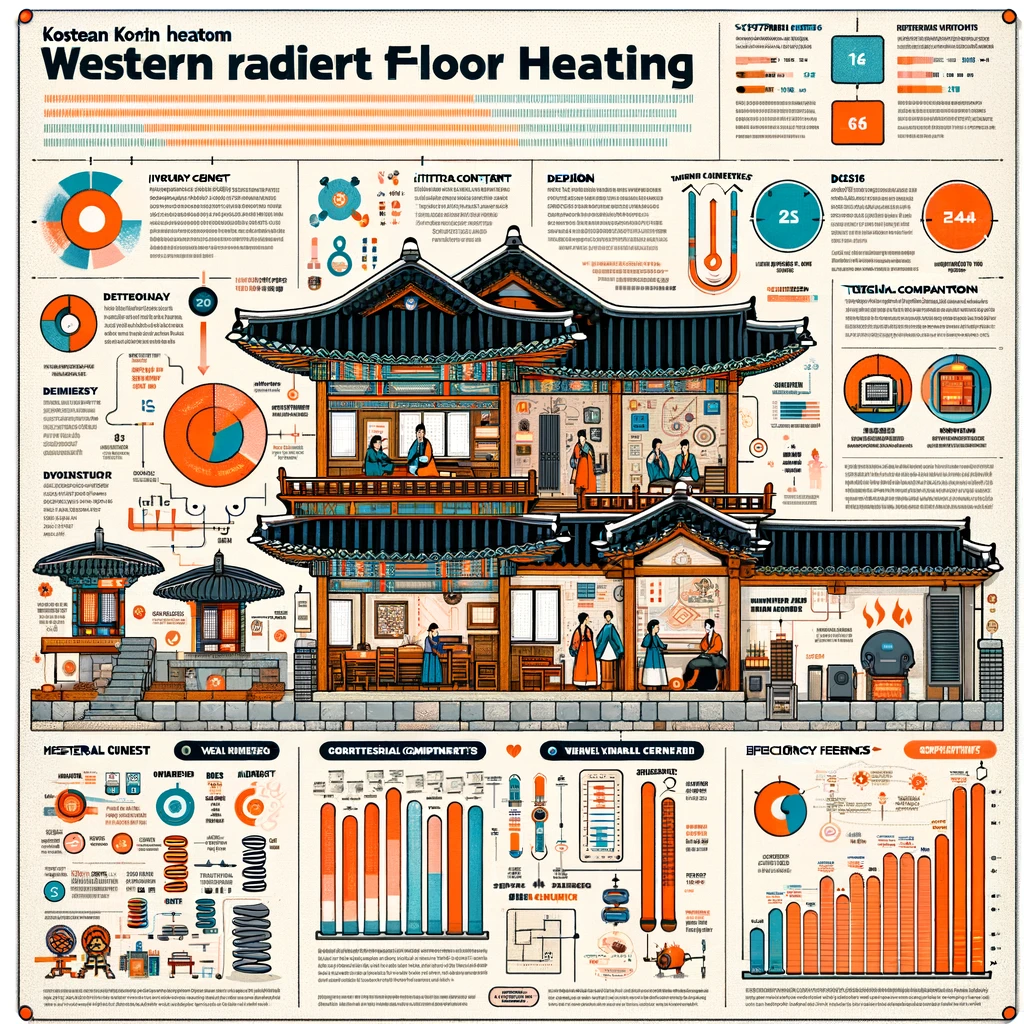목차
Ondol vs Western Radiant Floor Heating
Introduction
The concept of heating from beneath the floor is an ancient technique that has evolved across various cultures, most notably in Korea with the traditional ondol system and in the West with modern radiant floor heating. Both systems aim to provide efficient, comfortable heat in a building environment, but they do so with different methodologies and cultural backdrops. This detailed blog post will explore the similarities and differences between these two heating systems, delving into their historical contexts, design principles, efficiency, and impact on modern sustainable architecture.

Historical Context and Development
Ondol (Korean Underfloor Heating):
Origin: The ondol system has its roots in ancient Korea, dating back to the Proto-Three Kingdoms period. Initially, it was a rudimentary form of heating that involved smoke channels under stone floors.
Evolution: Over centuries, the system evolved and became an integral part of Korean residential architecture, especially noted during the Joseon Dynasty. The traditional ondol was designed to use wood smoke from cooking fires to heat the large stones under the floor, which then radiated warmth into the living spaces.
Western Radiant Floor Heating:
Origin: The concept of radiant floor heating can be traced back to the Roman hypocaust, a system that heated rooms from a furnace below the floor. This ancient system fell out of use with the decline of the Roman Empire but saw a resurgence in the modern era with new technologies.
Evolution: Modern radiant floor heating systems use either electric resistance elements or fluid flowing in pipes to generate heat. Unlike the traditional ondol, these systems are often integrated during the initial construction phase and are controlled with advanced thermostats.
Design and Technical Specifications
Ondol:
Materials: Uses natural stones and bricks to construct the heating passage and floor.
Heat Source: Traditionally, wood or charcoal; modern versions may use electricity or gas.
Distribution: Heat is distributed through natural convection and radiation, requiring good insulation to be effective.
Western Radiant Floor Heating:
Materials: Often uses PEX tubing (cross-linked polyethylene) for hydronic systems or thin electric mats for electric systems.
Heat Source: Electric coils or hot water heated by boilers or solar heating systems.
Distribution: Heat is distributed evenly across the floor, and the system is typically zoned to control temperature variations in different rooms.
Efficiency and Energy Use
Ondol:
Energy Efficiency: Highly efficient due to the thermal mass of stones retaining heat long after the heat source is turned off.
Sustainability: Wood used to be the primary energy source, but modern adaptations include more sustainable options like gas or solar energy.
Western Radiant Floor Heating:
Energy Efficiency: Hydronic systems are particularly energy-efficient, especially when integrated with solar water heating.
Sustainability: Electric systems may draw on renewable energy sources, though they can also consume a significant amount of electricity.
Cultural and Practical Impacts
Ondol:
Cultural Significance: Deeply integrated into Korean life, influencing traditional home layouts and living habits.
Practical Use: Best suited for continuous heating in cold climates due to the slow response time in adjusting temperatures.
Western Radiant Floor Heating:
Cultural Significance: Viewed as a luxury feature in modern construction, adding significant value to properties.
Practical Use: Offers flexible design and quicker temperature adjustment, suitable for diverse climates and intermittent use.
Conclusion
Both ondol and Western radiant floor heating systems offer unique advantages that stem from their respective historical developments and technological advancements. Ondol is celebrated for its deep cultural roots and natural efficiency, making it ideal for sustained heating in residential spaces. Western radiant floor heating, on the other hand, provides modern convenience and precision control, appealing to contemporary architectural needs.
The choice between these systems often comes down to personal preference, environmental considerations, and specific architectural requirements. As the world increasingly focuses on sustainability, the principles behind both ondol and Western radiant heating systems continue to influence new developments in heating technology, driving forward the evolution of efficient and comfortable living environments.
Go Blog Home
